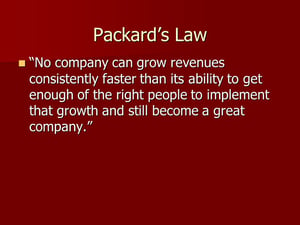 “No business can grow faster than their people.”
“No business can grow faster than their people.”
“No company can grow revenues consistently faster than its ability to get enough of the right people to implement that growth and still become a great company. [And] If a company consistently grows revenue faster than its ability to get enough of the right people to implement that growth, it will not simply stagnate; it will fall.“
~David Packard.
In Good to Great, Jim Collins shared Packard’s Law. It aligns with Collins’ “First Who, Then What.”
To Grow, Your Business needs good people
David Packard recognized the critical need to grow his people in order to continue to grow his business.
Always Be Hiring
“Always be Hiring!” One of my customer’s leadership team, their new CEO, shared this lesson when reviewing what the company needs to work on. We’d just completed their 4th quarter planning. Their goal this year is to hire 15 people. They’re well ahead of pace and plan to hire two more before the quarter ends. Revenue is up 30% this year!
Their plan doubles revenue in the next two years. They know they need good people to continue their growth rate.
Make the Hiring Process Challenging
It may seem counter intuitive with unemployment so low, and the number of qualified candidates for jobs sparse, to make your candidates jump through hoops in order to get a job with you. However, candidates who have to work for a position value it more. When you must work for it, it means more.
In a recent job interview I facilitated, one candidate commented how rigorous the process and questions were. He liked how we were discovering who he was, and what motivates him. He felt encouraged by the hiring interviews because we were being so thorough.
Topgrading Tools
The Topgrading process we recommend, and help my customers create, is a must when hiring your management team.
It’s rigorous. It focuses on job performance. After investing 5+ hours with a candidate you gain understanding not only of the candidates past performance but also how good a fit they are in your culture.
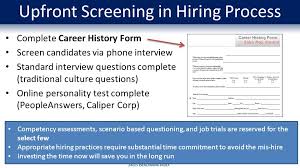 The screening interview can be 30-60 minutes. Done on the phone, it focuses on the last two positions of the candidate’s discovering their responsibilities, accomplishments, manager’s strengths and weaknesses, and what their manager would indicate their strengths and weaknesses.
The screening interview can be 30-60 minutes. Done on the phone, it focuses on the last two positions of the candidate’s discovering their responsibilities, accomplishments, manager’s strengths and weaknesses, and what their manager would indicate their strengths and weaknesses.
Why do we ask what the candidate’s evaluation of their manager would be? To get an idea of how they like to be managed. Also, to discover what might disappoint or possibly annoy them when being managed.
While I’m no longer 100% on the value of competencies or how well we can rate others,(see Lie 6: People Can Reliably Rate Other People - Idiosyncratic Rater Effect) the competency interview (usually 1-2 hours done with a tandem interviewer) helps discover how proficient the candidate is in several critical capabilities for the specific position you are hiring for. Focusing on the competencies which are most difficult to change (See Chart) helps you determine whether the candidate is able meet the accountabilities for the position at a high level. 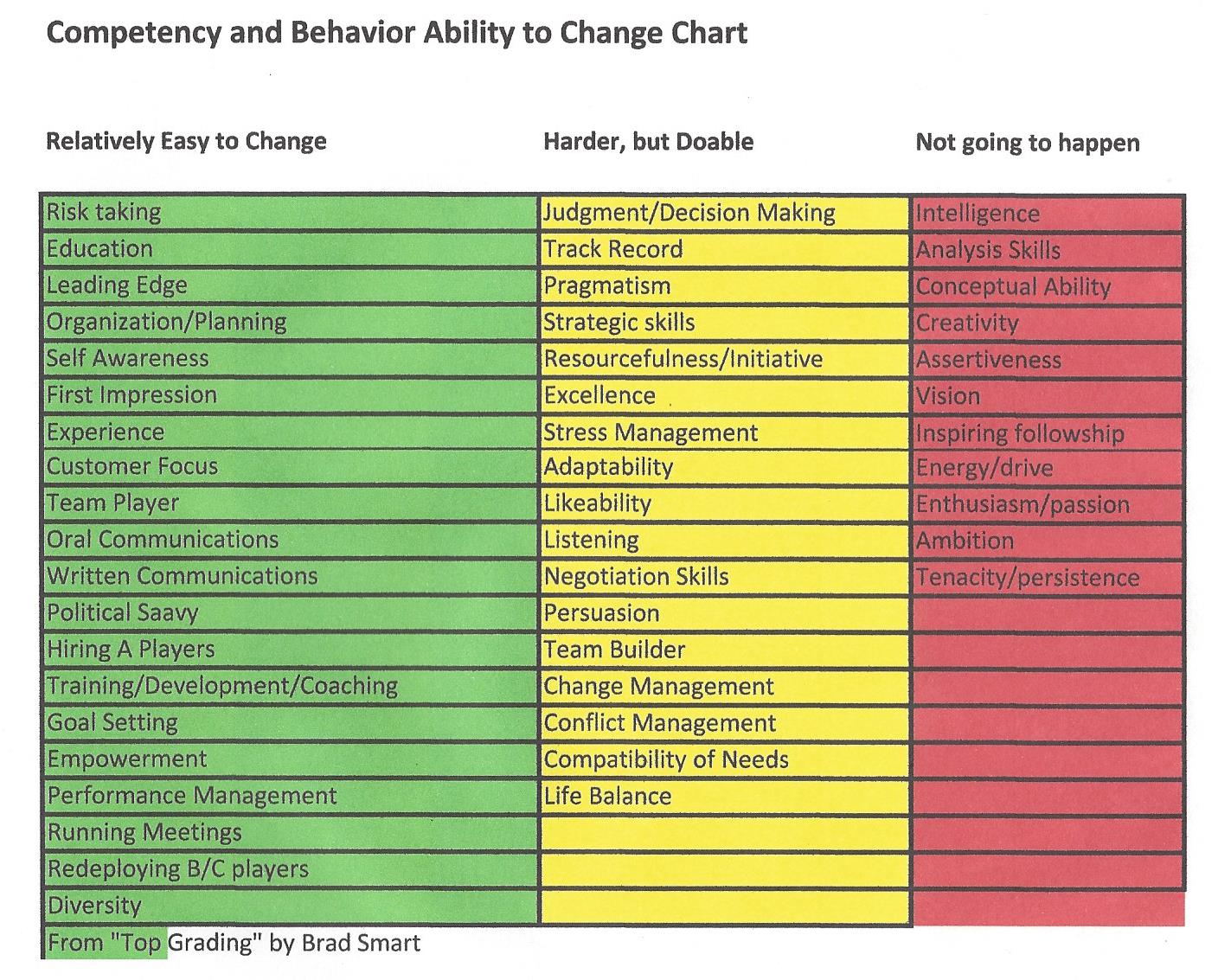
In the same interview with the young man who commented about the intensity and length of our interviewing process, we asked several questions on integrity. The company he worked for had recently established a no smoking policy on their property. He was reporting to his supervisory position on the third shift one evening when he met several employees from the 2nd shift who were smoking on the property. He approached them, started a conversation with them first, then after a brief chat, he casually brought up the new policy. He told them if they planned to continue to smoke to go across the street.
His behavior told us he was all in on following his company’s rules and policies, not afraid to endorse them, even with people who were not his responsibility. He is exactly the kind of manager my customer is looking for!
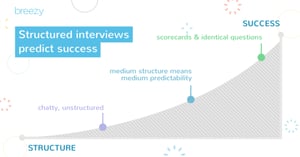 The final Topgrading interview can take up to three hours and not only explores up to 6 of the past jobs the candidate had; it also discovers their high school and college background. Resourcefulness, initiative, and success start early. Finding someone who demonstrates motivation, attitude, and drive early in life frequently reveals discipline and habits driving performance in the present.
The final Topgrading interview can take up to three hours and not only explores up to 6 of the past jobs the candidate had; it also discovers their high school and college background. Resourcefulness, initiative, and success start early. Finding someone who demonstrates motivation, attitude, and drive early in life frequently reveals discipline and habits driving performance in the present.
Finding the right people to help your company grow requires an exacting set of standards and questions to help you discover the best performers.
Need help establishing an effective hiring process. Call Doug Wick at 319-393-2565.
Growth demands Strategic Discipline.
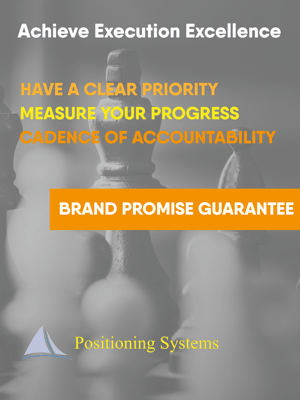 How can you build an enduring great organization?
How can you build an enduring great organization?
You need disciplined people, engaged in disciplined thought, to take disciplined action, to produce superior results, to make a distinctive impact in the world.
Discipline sustains momentum, over a long period of time, to lay the foundations for lasting endurance.
It’s the framework for Good to Great:
- Stage 1: Disciplined People
- Stage 2: Disciplined Thought
- Stage 3: Disciplined Action
- Stage 4: Build Greatness
A winning habit starts with 3 Strategic Disciplines: Priority, Metrics and Meeting Rhythms. -2.jpg?width=300&name=3%20Disciplines%20of%20Execution%20(Strategic%20Discipline)-2.jpg) Forecasting, accountability, individual, and team performance improve dramatically.
Forecasting, accountability, individual, and team performance improve dramatically.
Meeting Rhythms achieve a disciplined focus on performance metrics to drive growth.
Positioning Systems helps your business achieve these outcomes on the Four most Important Decisions your business faces:
|
DECISION |
RESULT/OUTCOME |
|
PEOPLE |
|
|
STRATEGY |
|
|
EXECUTION |
|
|
CASH |
|
Positioning Systems helps mid-sized ($5M - $250M) business Scale-UP. We align your business to focus on Your One Thing! Contact dwick@positioningsystems.com to Scale Up your business! Take our Four Decisions Needs Assessment to discover how your business measures against other Scaled Up companies. We’ll contact you.
![]() Next Blog – American Icon
Next Blog – American Icon
When I first read American Icon: Alan Mulally and the Fight to Save Ford Motor Company by Bryce G. Hoffman, I was surprised by similarities to our Scale Up methods Mulally used. I’ve already shared his Cadence of Accountability – How Alan Mulally Rid Ford of Poor Performers. Next blog, key metrics, and ideas Mulally used to grow momentum.






.jpeg?width=150&height=135&name=Hand%20with%20marker%20writing%20the%20question%20Whats%20Next_%20(1).jpeg)

